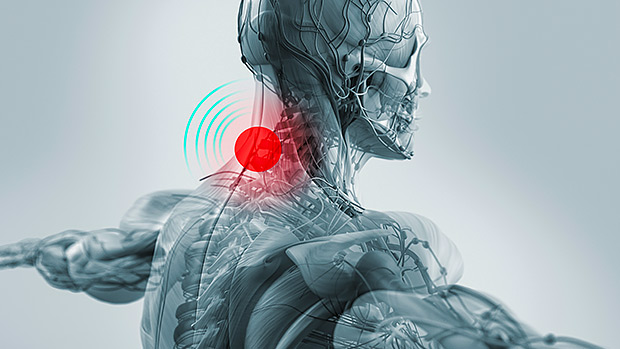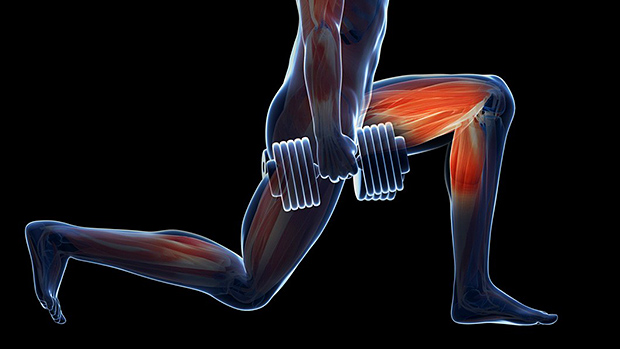Tightness in the upper traps is a pandemic. A new systematic review suggests that 52-90% of office workers suffer neck pain (1). The good news? Targeted resistance training is effective for reducing neck and trap pain (1,2).
A 20-week study showed that simple dumbbell exercises decreased neck and upper-back pain among office workers (2). The exercises were shrugs, front raises, lateral raises, reverse flyes, and wrist extension curls (2,3).
The training plan below includes upgraded versions of the first four exercises followed by a few joint and soft tissue techniques.
1. Modified Gittleson Shrug
This is THE most effective exercise for chronically "tight" traps. Here's how to do it:
- Sit on a bench. Grab a dumbbell or a kettlebell and allow it to hang at your side. With your other hand, grab the edge of the bench to stabilize.
- Side-bend your neck away from the weighted arm, flex your neck forward, and rotate your head slightly toward the weighted arm. You should be looking at the floor in front of your weighted arm and feeling a full stretch on your upper trapezius.
- As you lift your shoulder, simultaneously pull your neck into extension, side-bending toward the weighted arm, and rotating away from it. Bring the top of your shoulder to your hairline. Squeeze in the fully contracted position.
- Slowly control the weight back to the start position as you return your neck into flexion. Get a momentary full stretch on the upper trapezius before beginning the next rep.
- Complete all reps, turn around, then do the other side.
Rather than a traditional shrug, I recommend this modified version of the Gittleson Shrug. What's different?
The modified version exaggerates the range of motion and eccentric/negative portion of the lift. You'll get a tri-planar stretch on the upper trap area and the small facet joints of the neck. The weight you use should be about 33-percent lighter than your typical weight for a unilateral shrug or Gittleson shrug.
2. Seated Alternating Front Raise
- Sit on a bench, trunk unsupported, and eyes straight ahead. Hold a pair of dumbbells at your sides, then do alternating front raises to your eye line.
- Keep a controlled tempo and motionless trunk.
Although the original study protocol specified internally rotated/palms-down front raises, neutral rotation is more shoulder-friendly and just as effective. Doing them seated helps keep body-sway to a minimum.
3. High-Incline Bench Lateral Raise
- Set an adjustable bench to a high incline (ideally 70-85 degrees). With your abdomen and sternum in contact with the bench, do lateral raises. You may have to semi-squat depending on the height of your bench.
- Maintain a slight bend in your elbows. Don't allow the dumbbells to come together at the bottom of the rep.
- Keep a smooth, controlled tempo and relatively motionless trunk to minimize momentum.
- Maintain a slightly pronated forearm position – palms down – for the lateral raise. However, you may adjust the shoulder rotation and palm position to make it more comfortable.
- If your bench starts to slide forward, place a heavy dumbbell or stack of plates in front of it.
4. Seated Reverse Flye
- Perch yourself at the end of a bench. Place your feet under your shoulders.
- Bend forward at the waist and do reverse flyes with a neutral forearm and shoulder rotation. Think palms in and down.
- Keep a smooth, controlled tempo and relatively motionless trunk to minimize momentum.
By doing reverse flyes in this fashion – seated, feet pulled under, gut on your thighs – you'll keep your form honest. This is a very effective exercise for the posterior delts and the back of the rotator cuff.
5. Passive Retraction with Axial Lengthening
- Place one hand under the back of your skull and the other on your maxilla. That's the bone above your front teeth.
- Apply a light vertical "lift" with the hand behind your skull. With your front hand, gently guide your skull and neck rearward by pushing toward your earlobes. As you create this retraction, you should feel light tension behind the neck.
- Hold for 5 relaxed breath cycles. Rest. Repeat 3-5 rounds or as needed.
Aside from forcing you to smell whatever you've gotten your hands into earlier, this technique addresses stiffness that might be present in tissues around the small joints of the neck.
It allows you to access end-range neck retraction, which is the opposite neck position of where many of us tend to spend our days... usually at a computer or phone with chin and head jutted in front of our shoulders.
6. Self-Suboccipital Release
- Lie on your back. (In the video, I begin upright to show you where to place your thumbs.)
- Place the pads of your thumbs just under your skull on both sides of your neck's midline. To find the correct location, feel for where bone transitions to soft tissue. This soft tissue may be tender to pressure. That's the spot. Wrap your fingers over the top of your head.
- Allow the weight of your head to sink into your thumbs. While keeping thumbs slightly bent and providing counter-pressure through the fingertips, dig them upwards into the soft tissue of the neck.
- Hold for 5 relaxed breath cycles. Rest and repeat for 3-5 rounds, or as needed.
This technique addresses the suboccipital muscles. These small muscles span from the top of the neck to the skull and are prone to tightness. If you happen to suffer a tension headache in the future, try this self-suboccipital release.
However, the exercise protocol this program is based on was shown to decrease the frequency of headaches, so you might not get the chance to test it any time soon!
Do the exercises for three sessions per week on non-consecutive days. Like any resistance training program, consistency and progressive overload are necessary.
Here's the plan:
- Week 1: For each exercise, use a weight you can lift 20 times (your 20RM). Do 5 sets of 20 each.
- Weeks 2-4: Use a 15RM weight and do 5 sets of 15 reps per exercise.
- Weeks 6-8: Use a 12RM weight and do 6 sets of 12 reps per exercise.
- Weeks 8 and up: Use a 10RM weight and do 6 sets of 10 reps per exercise.
You can do the joint and soft tissue techniques as needed and repeated multiple times daily if they bring relief.
Work-related cervicogenic pain, which is pain arising from the muscles, bones, and associated structures of the neck, will benefit from building local strength and endurance. It also benefits from the training process itself. Most lifters see meaningful improvements in upper trap and neck symptoms within 2-3 months of consistent training (1,3).
Additional direct neck strengthening may provide more benefit. I cover some neck exercises in the Smart Lifer's Neck Training Program.
Like the original protocol for office workers, this is a high-volume and high-effort program. It's not for everyone. But if a bunch of average Joes could accomplish it in the original study, you should be able to handle it.
The modified Gittleson shrug, the passive retraction with axial lengthening, and the self-suboccipital release exercises may place the neck in extreme positions.
That means they may not be appropriate for everyone, including but not limited to those with recent trauma or surgery, those who've acquired ligament laxity (like from whiplash), and those with vascular problems or diseases.
Additionally, not all neck pain can be treated with exercise. Those having or suspecting any of the above, those showing nerve symptoms (a loss of sensation and/or strength, changes in bowel/bladder), and those with other changes in health status should seek a qualified medical checkup.
The info provided here is for educational purposes only and does not constitute individualized medical or rehabilitation advice. No client-provider relationship is implied.
- Frutiger M et al. Systematic review and meta‐analysis suggest strength training and workplace modifications may reduce neck pain in office workers. Pain Practice. 2020 Jul;21(7):100-131.
- Gram B et al. Effect of training supervision on effectiveness of strength training for reducing neck/shoulder pain and headache in office workers: cluster randomized controlled trial. Biomed Res Int. 2014;2014:693013. PubMed.
- Andersen LL et al. Protocol for work place adjusted intelligent physical exercise reducing musculoskeletal pain in shoulder and neck (VIMS): a cluster randomized controlled trial. BMC Musculoskelet Disord. 2010 Aug 5;11:173. PubMed.





